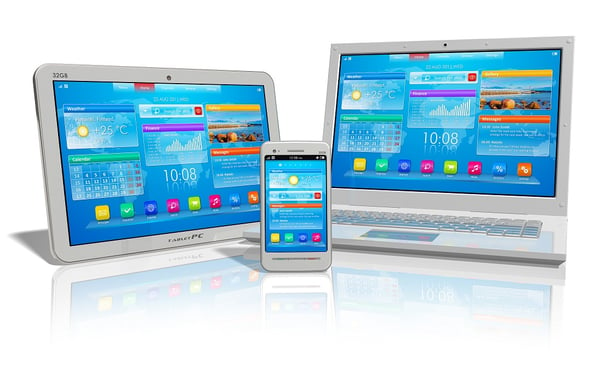Published on
Online and On the Move

Mobile learning, devices and apps are hot topics in education. Though I tend to become very excited about the potential of new technologies and, to be honest, their “cool factor,” it is important to remember the purpose for implementing them. Does the technology assist students in achieving the objectives of the course? Does it improve outcomes? Increase learning? Improve access? As educators we should carefully consider the move toward mobile learning, including these key issues:
The cloud is fuel for mobile learning: Moving to smaller devices and thin clients that rely on the cloud improves accessibility, “share-ability,” boot-up speeds and back-up processes. Faster devices and multiple devices synced to one another improve the ease with which we transition from phones to tablets to laptops for teaching and learning in the continuum of online education.
Along with these benefits, though, come challenges. Who owns your data? What about security?
Mobile pedagogy, teaching, and learning: Just-in-time, contextual information will transform training and experiential learning. Mobile devices give students the opportunity to carry a mentor or expert in their pockets. As you design mobile experiences, you should consider the learning context.
Where and when will students consume this content? Will they be distracted? Does the smaller format affect your resource choices? Mobile devices also enable teachers to capture examples in the field and gather immediate feedback from students. You might consider interviewing experts at conferences or creating video-based field trips.
Apps, Apps, and MORE Apps: A “critical mass”—62 percent—of cell phone users age 25-34 own smart phones.[1] Though web-enabled phones allow us to surf the Internet, apps for mobile devices receive much higher usability ratings.[2] The major players are certainly Google Android, Apple iOS and their affiliated app stores; however, focusing solely on these platforms may isolate many users (Windows, RIM Blackberry).
How does an institution, or individual instructor, address all these platforms? Can they?
Internet access on cell phones and 4G: According to the Pew Internet and American Life Project, a “majority of adult cell owners (55%) now go online using their phones.”[3] Coupled with broad adoption of mobile internet, the increased speed of cellular data networks makes mobile browsing more appealing and convenient. The adoption of such technologies may offer minority students increased access to education, as the Pew study indicates that African-Americans and Latinos are accessing the web through mobile devices at higher rates. Limited bandwidth for cell phones in rural areas is still a concern.
How to do we support adoption of new mobile technologies without isolating students with inadequate mobile broadband access?
New technologies, 3-D and Neural Control: Vendors are developing devices to enable 3-D viewing on mobile devices, which could be transformational for STEM education. Researchers at Dartmouth are exploring neural control for mobile devices.[4] The ability to control a device with your thoughts would be powerful for students with motor impairments, though the questions it raises are astounding. For instance, could someone hack your brain?
The need for thoughtful adoption of mobile learning will only grow. A faculty member recently told me of his trip to The Gambia; young people there did not have clean drinking water, but all were carrying cell phones. VentureBeat reports that “tablet computers are expected to overtake sales of notebook computers by the end of 2016.”[5] All this begs the question: Will we be ready?
Ray Schroeder and Emily Boles will present “Online and On the Move,” a pre-conference workshop at the Sloan Consortium’s International Conference on Online Learning on October 10, 2012. For more information on their presentation, please click here.
– – – –
References
- Jenna Wortham. “Most Young Adults in U.S. Now Own Smartphones, Survey Says.” New York Times Bits Blog. http://bits.blogs.nytimes.com/2011/11/03/most-young-americans-now-own-smartphones-survey-says/
- Jakob Neilsen’s Alertbox. “Mobile Usability Update.” September 26, 2011. http://www.useit.com/alertbox/mobile-usability.html
- Aaron Smith. “Cell Phone Internet Use 2012.” Pew Internet and American Life Project. http://www.pewinternet.org/~/media/Files/Reports/2012/PIP_Cell_Phone_Internet_Access.pdf
- People Aware Computing Group. Dartmouth College. http://pac.cs.dartmouth.edu/
- Dean Takahashi. “Tablet computer sales will overtake notebooks by 2016.” VentureBeat. http://venturebeat.com/2012/08/15/tablet-computer-sales-will-overtake-notebooks-by-2016/
Author Perspective: Educator



